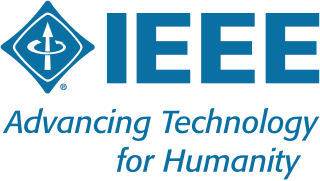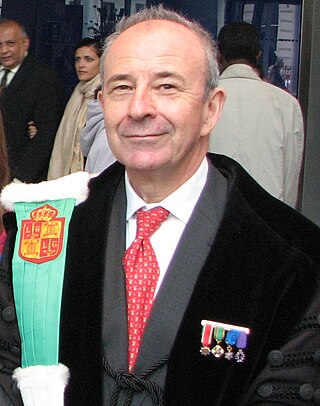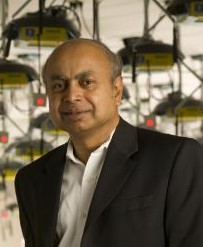Related Research Articles

The Institute of Electrical and Electronics Engineers (IEEE) is a 501(c)(3) professional association for electronics engineering, electrical engineering, and other related disciplines with its corporate office in New York City and its operations center in Piscataway, New Jersey. The mission of the IEEE is advancing technology for the benefit of humanity. The IEEE was formed from the amalgamation of the American Institute of Electrical Engineers and the Institute of Radio Engineers in 1963.

Creativity is a phenomenon whereby something new and valuable is formed. The created item may be intangible or a physical object.
Peter Pin-Shan Chen is a Taiwanese American computer scientist. He is a (retired) distinguished career scientist and faculty member at Carnegie Mellon University and Distinguished Chair Professor Emeritus at LSU. He is known for the development of the entity–relationship model in 1976.
Human-centered computing (HCC) studies the design, development, and deployment of mixed-initiative human-computer systems. It is emerged from the convergence of multiple disciplines that are concerned both with understanding human beings and with the design of computational artifacts. Human-centered computing is closely related to human-computer interaction and information science. Human-centered computing is usually concerned with systems and practices of technology use while human-computer interaction is more focused on ergonomics and the usability of computing artifacts and information science is focused on practices surrounding the collection, manipulation, and use of information.

David A. Bader is a Distinguished Professor and Director of the Institute for Data Science at the New Jersey Institute of Technology. Previously, he served as the Chair of the Georgia Institute of Technology School of Computational Science & Engineering, where he was also a founding professor, and the executive director of High-Performance Computing at the Georgia Tech College of Computing. In 2007, he was named the first director of the Sony Toshiba IBM Center of Competence for the Cell Processor at Georgia Tech. Bader has served on the Computing Research Association's Board of Directors, the National Science Foundation's Advisory Committee on Cyberinfrastructure, and on the IEEE Computer Society's Board of Governors. He is an expert in the design and analysis of parallel and multicore algorithms for real-world applications such as those in cybersecurity and computational biology. His main areas of research are at the intersection of high-performance computing and real-world applications, including cybersecurity, massive-scale analytics, and computational genomics. Bader built the first Linux supercomputer using commodity processors and a high-speed interconnection network.

Mar Baselios College of Engineering and Technology(Autonomous), is an engineering educational institution located at Thiruvananthapuram, Kerala, India offering engineering education and research. The college is located on a hillock in the Bethany Hills. The educational Institution is situated along the way from Kesavadasapuram to Mannanthala route, this road further extends to north of Kerala as the MC Road.

Sami Erol Gelenbe, a Turkish and French computer scientist, electronic engineer and applied mathematician, pioneered the field of Computer System and Network Performance in Europe. Active in European Union research projects, he is Professor in the Institute of Theoretical and Applied Informatics of the Polish Academy of Sciences (2017-), Associate Researcher in the I3S Laboratory and Abraham de Moivre Laboratory. Previous Chaired professorships include the University of Liège (1974-1979), University Paris-Saclay (1979-1986), University Paris Descartes (1986-2005), ECE Chair at Duke University (1993-1998), University Chair Professor and Director of EECS, University of Central Florida (1998-2003), and Dennis Gabor Professor and Head of Intelligent Systems and Networks, Imperial College (2003-2019).

Computational creativity is a multidisciplinary endeavour that is located at the intersection of the fields of artificial intelligence, cognitive psychology, philosophy, and the arts.
Posthuman or post-human is a concept originating in the fields of science fiction, futurology, contemporary art, and philosophy that means a person or entity that exists in a state beyond being human. The concept aims at addressing a variety of questions, including ethics and justice, language and trans-species communication, social systems, and the intellectual aspirations of interdisciplinarity.

Ronald Fagin is an American mathematician and computer scientist, and IBM Fellow at the IBM Almaden Research Center. He is known for his work in database theory, finite model theory, and reasoning about knowledge.
The Ken Kennedy Award, established in 2009 by the Association for Computing Machinery and the IEEE Computer Society in memory of Ken Kennedy, is awarded annually and recognizes substantial contributions to programmability and productivity in computing and substantial community service or mentoring contributions. The award includes a $5,000 honorarium and the award recipient will be announced at the ACM - IEEE Supercomputing Conference.

Christopher Ray Johnson is an American computer scientist. He is a distinguished professor of computer science at the University of Utah, and founding director of the Scientific Computing and Imaging Institute (SCI). His research interests are in the areas of scientific computing and scientific visualization.

Sethuraman Panchanathan is an Indian-American computer scientist and academic administrator, and the 15th Director of National Science Foundation since June 2020. He previously served as the Executive Vice President, ASU Knowledge Enterprise Development and Chief Research and Innovation Officer at Arizona State University (ASU). He was also Director of the Center for Cognitive Ubiquitous Computing (CUbiC), Foundation Chair of Computing and Informatics at ASU and Professor in the School of Computing, Informatics, and Decision Systems Engineering (CIDSE), part of the Ira A. Fulton Schools of Engineering.
Science fiction prototyping (SFP) refers to the idea of using science fiction to describe and explore the implications of futuristic technologies and the social structures enabled by them. Similar terms are design fiction, speculative design, and critical design.

Biswanath Mukherjee is an Indian-American Distinguished Professor of computer science at University of California, Davis. He is also a fellow of IEEE.
Design fiction is a design practice aiming at exploring and criticising possible futures by creating speculative, and often provocative, scenarios narrated through designed artifacts. It is a way to facilitate and foster debates, as explained by futurist Scott Smith: "... design fiction as a communication and social object creates interactions and dialogues around futures that were missing before. It helps make it real enough for people that you can have a meaningful conversation with".
Micro-SFP (µSFP) describes an ultra-short science-fiction story written for the specific purpose of capturing inventive ideas for product or service innovations. It is a combination of three concepts, first science-fiction prototyping, second flash fiction and finally, Twitter and texting.
Threatcasting is a conceptual framework used to help multidisciplinary groups envision future scenarios. It is also a process that enables systematic planning against threats ten years in the future. Utilizing the threatcasting process, groups explore possible future threats and how to transform the future they desire into reality while avoiding undesired futures. Threatcasting is a continuous, multiple-step process with inputs from social science, technical research, cultural history, economics, trends, expert interviews, and science fiction storytelling. These inputs inform the exploration of potential visions of the future.

Dipankar Raychaudhuri is the Director of Wireless Information Network Laboratory (WINLAB) and distinguished professor in the Electrical and Computer Engineering department at Rutgers University.
References
- ↑ Creative Science: Injecting Innovation into the IT Industry, Oxford Journals, ITNOW (Summer 2015) 57 (2): p52-55
- ↑ When Science Fiction and Science Fact Meet, IEEE Computer, Issue No.1 Vol.46, 2013.
- ↑ A New Doorway into Time, IEEE Computer, Volume:47, Issue: 5, p99-101, ISSN 0018-9162, May 2014
- ↑ Creative Science Foundation web pages, accessed 25.5.15